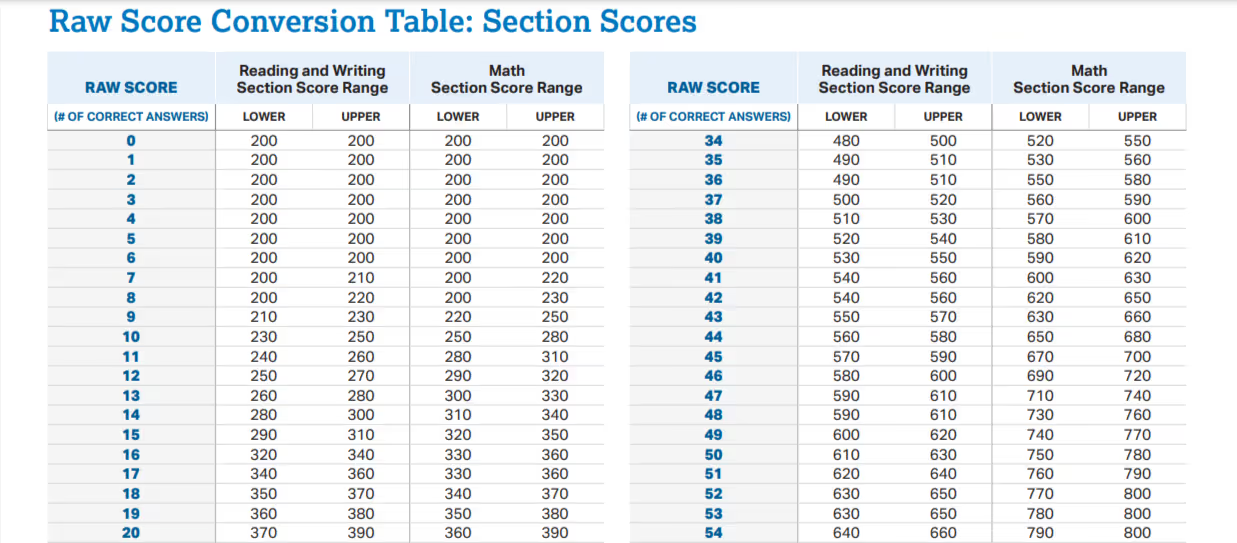




Key Takeaways
- Digital SAT Scoring Explained: Your raw score is simply the number of correct answers, but your final scaled score is adjusted using standardization to ensure fairness across different test dates and difficulty levels.
- Adaptive Testing for Accurate Assessment: The digital SAT adapts its difficulty based on your performance, ensuring the questions match your skill level for a more precise evaluation.
- Score Reporting and Timing: After completing the test, you'll receive your scores in under two weeks, providing a quick turnaround for your college applications.
Whenever we answer the question 'How the Digital SAT is scored?', some students ask a different question. And that is: Why is the SAT scored the way it is?
Before we explain the digital SAT scores and their importance, we need to take a quick look at the test itself.
The Digital SAT: A Quick Primer
While the digital SAT has several points worth understanding, here are the main ones:
- There are two sections, and each section has two modules. The first section assesses students' reading and writing skills, while the second assesses their math skills.
- The first section has 54 questions to be answered in 64 minutes. Against that, the second section has 44 questions for which you have 70 minutes.
- You have 2 hours and 14 minutes within which to answer 98 questions.
- The digital SAT is an adaptive test. As a result, your performance in the first module in each section decides which module you'll be served next. You can learn more about the adaptive nature of the SAT here.
- If you're served difficult questions in the adaptive modules, the minimum you can score will always be more than the maximum if you are served easy questions in the adaptive module.
The table below summarizes the digital SAT test breakup:

Now, we're closer to understanding digital sat scores than before.
How is the digital SAT scored?
No matter what changes the College Board makes in the SAT, they want to make sure your skills are evaluated as accurately as possible.
To understand everything about scores of the digital SAT, you first need to understand what is the raw score on the digital SAT
Your digital SAT is a standardized test conducted across the US and internationally. More importantly, it is a critical factor for college admissions. The College Board cannot grade it like your substitute teacher grades your class quiz - standardized testing is way too critical.
First, let's answer a basic question: what are raw scores in the SAT?
SAT raw scores
In the SAT, your raw score is the number of questions you got right. Since the SAT is not penalised for an incorrect answer, your raw score is unaffected by wrong answers. No marks are taken away for not answering a question, either. Effectively, the range for raw score for the Reading and Writing section is 0 to 54, while that for the Math section is 0 to 44.
So, if you attempt 40 questions in the Reading and Writing section and have 31 questions correct, your raw score is 31. Similarly, if you correctly attempt 34 questions in the Math section, your raw score for Math is 34.
You got 31 + 34 = 65 correct, which is your total raw SAT score.
However, this is not your final score for several reasons.
Like, for instance, the raw score doesn't take into account whether you had the difficult adaptive module or the easier one. Besides, the number of questions in the two sections is different, so there has to be a mechanism that would bring the scores at par with each other.
Your scaled scores
Your digital SAT score report card will show a score in the range of 200 to 800 for each section. That means your composite score for the dSAT will fall between 400 and 1,600.
To convert your raw scores into scaled scores, the College Board uses standardization. Do not confuse this with grading on a curve - the Digital SAT does not grade on a curve. Learn more about digital SAT curve
What is standardization?
The SAT questions on a particular test date may be more difficult than those on another date. Also, each question aims to assess specific skills, so questions on different dates may have assessed slightly different skills.
In the absence of a balancing mechanism, the scores will not accurately reflect students' capabilities. Also, colleges will receive inconsistent scores, which will weaken their admission process.
Despite the apparent differences in questions, standardization balances the overall test. The difficulty level, skills tested, the kind of answer choices against the questions, domain knowledge and concepts evaluated, and standardization makes sure that SATs administered on different testing dates remain consistent and similar.
Consider Lisa and Brad. Lisa took her digital SAT just two days back, while Brad appeared for the SAT over a month back. Both got precisely 37 questions correct in the Math section. Yet, Lisa scored 700 in the Math section, while Brad received 720.
Standardization is the reason behind this difference. The kind of questions that Lisa was served were slightly easier than those that Brad was served. The degree to which the questions could differentiate the skill levels was different. A few of the answer choices that Lisa received made it easy for her to guess.
Reported scaled scores
Using a proprietary algorithm, the College Board converts the raw scores into scaled scores. This algorithm uses standardization as its base.
So, first, your sectional raw scores are converted into scaled scores. Then the scaled scores of the two sections are simply added to produce the final total SAT score.
For various reasons, including confidentiality, the College Board doesn't disclose how they scale scores. Of course, they release conversion tables that tell you what range of raw scores would land you a particular scaled score.
This conversion remains almost identical on a yearly basis.
During your test prep days, you should target practicing with real SAT questions with the correct difficulty level. At EdisonOS, we've designed our full-length practice tests with this in mind. Our tests use authentic questions and ensure each question matches the difficulty level and domain of an actual SAT.
You can take a to see it for yourself.
How scaling and standardization help students and colleges
Among the many ways the new digital SAT is more effective, its ability to assess a student more accurately stands out.
Consider the example of Nina. She didn't do well in the first module of her Math section. She got several advanced math and geometry questions wrong. Now, if the test algorithm were to continue asking her advanced math and geometry questions in the second module, it'd make no sense. Nina would be unable to perform and the test would not be able to assess her other abilities like, say, problem-solving.
Instead, the adaptive module asks her easier questions. These are questions that Nina can answer comfortably. Consequently, the test algorithm accurately knows the kind of questions Nina can and cannot answer.
On the other hand, colleges that receive Nina's scores would know her strengths and weaknesses. As a result, the college could exempt her from one course or recommend another so that she is at par with the rest of the students in her batch.
How you can convert your raw score into scaled SAT scores
The College Board has published a few official SAT practice tests. Along with the answer key, you get a conversion table for each test. This table gives you the conversion for raw scores for the first practice test.

Can you use the same table for the rest of the practice tests? Or for the actual SAT?
No. You can't.
You can use this table as a reference to understand what you might score after your actual SAT. However, the College Board will give you a different conversion table for your own SAT.
Are scores on a paper and pencil SAT and digital SAT identical?
The College Board clearly says these two versions of the SAT "measure similar, but not identical, content". Hence, a paper and pencil test may not be the perfect way to predict what you might score on the digital SAT.
However, the College Board also states that the scores on these two different versions of the SAT are comparable. That means the students taking a paper and pencil SAT would be neither at an advantage nor at a disadvantage as compared to the students taking the digital SAT.
Is digital SAT easier or harder?
As we noted above, the College Board has clarified that the paper and pencil version of the SAT and the digital SAT measure similar areas.
Also, their scores are comparable. That means one version can't be more or less difficult than the other. Otherwise, their scores in the Reading and Writing sections could be higher or lower, owing to differences in, say, vocabulary. Or, the number of questions on, say, linear equations might upset the Math section score.
The College Board makes sure the two versions do not differ significantly. Hence, the digital SAT is neither easier nor harder than its paper and pencil counterpart.
When to expect your digital SAT scores
As a student, your next obvious question will be: When do digital SAT scores come out?
You will receive your SAT scores in under two weeks after you've taken the SAT. Sometimes, the scores may arrive sooner, but that doesn't happen often. If you don't receive your scores after two weeks, you may get in touch with the College Board.
What’s staying the same on the Digital SAT
In many ways, the digital SAT is similar to its paper-and-pencil test (which has been discontinued since December 2023). Here are the key elements that haven't changed:
- The digital SAT too is proctored. It is also conducted at designated test centers, the way paper-based SAT was.
- The minimum and maximum scores are 400 and 1,600 respectively, just like the written SAT.
- There are two sections, one testing the student's language skills and the other testing math skills. The paper version of the SAT too had the same divisions.
- There is no penalty (AKA negative marking) for a wrong answer, similar to the paper SAT.
- You can continue using a calculator in the math section, just like you could in the paper-and-pencil SAT.
How's the digital SAT different from the paper-and-pencil SAT
Overall
- The biggest difference is that the digital SAT is an adaptive test. It adjusts its questions based on the student's performance.
- The digital SAT is shorter. Earlier, the test was spread over 3 hours but now it is 2 hours and 14 minutes.
- You will see fewer questions on the digital SAT. Compared to the 154 questions in the paper-based SAT, the digital SAT has just 98 questions.
- You may only take it digitally. Approved devices include laptops, iPads, and school-managed Chromebooks.
- You will receive SAT scores a great deal earlier.
- Finally, because the question text has to fit inside a narrow block on the screen, it will be shorter in length. That's not to say they'll be easier; we're just saying that the questions will be more crisply worded.
Reading and writing Sections
- The essay section has been dropped.
- Passages will be shorter. The length of the passage is capped at 150 words.
- Each question will have its own passage. Earlier, several questions referred to the same passage.
Math Sections
- You may use the inbuilt calculator for the entire math section. The paper-based SAT allowed using a calculator for certain questions but not for others.
- You'll see fewer questions in the math section than before. Yet, the total score remains unchanged.
In conclusion, we'll say that getting a good SAT score is an integral part of your college admissions. So gear up and start preparing!
Frequently asked questions

Tutors Edge by EdisonOS
in our newsletter, curated to help tutors stay ahead!
Tutors Edge by EdisonOS
Get Exclusive test insights and updates in our newsletter, curated to help tutors stay ahead!
Recommended Reads
Recommended Podcasts












.png)
.webp)
